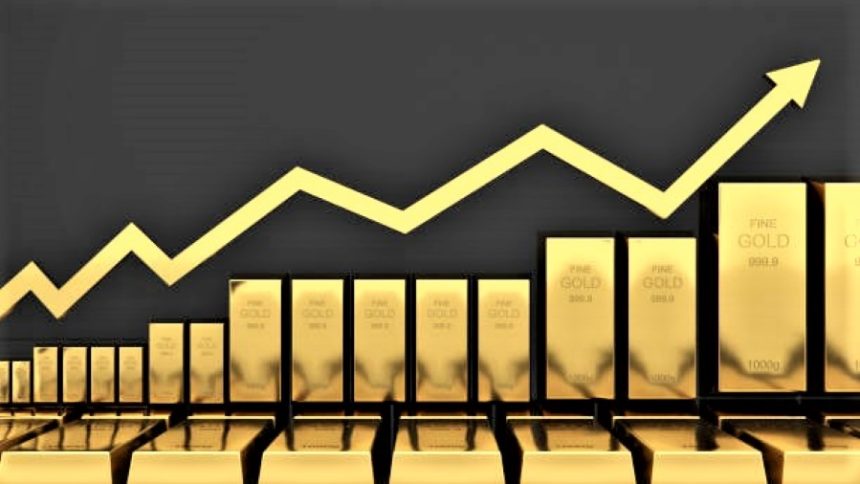Gold Hold Near Weekly Highs Amid Trump’s Trade Policy Uncertainty and Fed Rate Cut Bets.
Gold (XAUUSD) continues its upward trajectory, maintaining gains in the European session on Thursday and trading near the weekly top at around $3,035 per ounce. The precious metal’s resilience stems from mounting concerns over US President Donald Trump’s latest trade policies, which have reignited fears of a global economic slowdown. Market participants are also closely watching the Federal Reserve’s next moves, with increasing speculation that rate cuts could resume in 2025. A modest pullback in the US dollar from a multi-week high has further bolstered gold’s appeal as a safe-haven asset.
As global financial markets react to these developments, investors are keeping a close eye on upcoming US macroeconomic data, particularly Thursday’s Q4 GDP report, jobless claims, and home sales figures. However, the key focus remains on Friday’s release of the Personal Consumption Expenditure (PCE) Price Index, the Federal Reserve’s preferred inflation gauge, which could significantly influence market expectations regarding future interest rate adjustments.
Key Drivers Behind Gold Strength.
1. Escalating Trade Tensions and Safe-Haven Demand
Gold prices have been buoyed by the latest geopolitical and economic developments, particularly heightened trade tensions due to President Trump’s recent tariff policies. The US administration’s announcement of new auto tariffs has unsettled investors, raising concerns about potential retaliatory actions from major trade partners, including China and the European Union.
Adding to the uncertainty, Trump is expected to introduce reciprocal tariffs next week, further exacerbating fears of a trade war that could disrupt global supply chains and economic stability. Investors seeking safety from market volatility have turned to gold, a traditional safe-haven asset known for its ability to preserve value during times of uncertainty.
Federal Reserve’s Growth Outlook and Rate Cut Expectations
The Federal Reserve has also contributed to gold’s positive momentum by signaling a more dovish stance on monetary policy. In response to trade policy uncertainty and a potential economic slowdown, the Fed has revised its growth outlook downward. Policymakers have hinted at two potential 25-basis-point rate cuts in 2025, a move that would weaken the US dollar and make non-yielding assets like gold more attractive.
While recent US macroeconomic data, including durable goods orders and GDP growth, have shown resilience, Fed officials remain cautious about inflationary pressures and broader economic risks. Minneapolis Fed President Neel Kashkari acknowledged the progress made in reducing inflation but emphasized that more work remains to bring it back to the 2% target. Meanwhile, St. Louis Fed President Alberto Musalem cautioned that restrictive monetary policy is still needed to ensure inflation remains under control, further highlighting the uncertainty surrounding the Fed’s future rate decisions.
The prospect of lower interest rates typically weakens the US dollar, as investors move towards assets like gold, which do not offer yield but retain value during economic downturns. As a result, the anticipation of Fed rate cuts continues to underpin gold prices.
US Dollar Weakness and Treasury Yields
A modest pullback in the US dollar from a three-week high has provided additional support for gold prices. The US Dollar Index (DXY) had strengthened earlier in the week following stronger-than-expected durable goods orders data, which showed a 0.9% increase in February. However, as concerns over Trump’s aggressive trade policies and the Fed’s dovish signals took center stage, the greenback experienced some retracement, giving gold an opportunity to extend its gains.
Meanwhile, US Treasury bond yields have seen a slight uptick, which could act as a limiting factor for gold’s upward momentum. Higher yields make interest-bearing assets more attractive relative to non-yielding gold, leading to some resistance at higher price levels. However, overall market sentiment remains tilted towards safe-haven assets amid growing economic uncertainties.
China’s Economic Support Measures
Adding to the global economic landscape, China’s Vice Premier Ding Xuexiang recently pledged stronger policy support to stimulate the country’s economy. This announcement has provided a temporary boost to market risk sentiment, which could slightly dampen gold’s appeal as a risk-averse investment. However, the broader uncertainty surrounding US-China trade relations and global economic growth continues to drive demand for gold as a hedge against market volatility.
Upcoming Data and Market Expectations
While gold has been well-supported by geopolitical and monetary policy factors, traders are now turning their attention to key economic data releases that could determine its next directional move.
Thursday’s US Economic Docket
1. Final Q4 GDP Print – The revised GDP figure for the fourth quarter will provide insights into the overall health of the US economy. Any downward revision could reinforce expectations of Fed rate cuts, further boosting gold prices.
2. Weekly Initial Jobless Claims – A higher-than-expected increase in unemployment claims could signal weakness in the labor market, increasing the likelihood of monetary easing.
3. Pending Home Sales Data – Given the Fed’s cautious stance on interest rates, housing market performance could be another key factor influencing investor sentiment and the US dollar’s strength.
These reports will be closely monitored by market participants, as they could drive short-term fluctuations in gold prices and US dollar demand.
Friday’s PCE Inflation Data – The Game Changer
The most critical event of the week remains Friday’s release of the US Personal Consumption Expenditure (PCE) Price Index, the Fed’s preferred inflation measure. This report will provide a clearer picture of inflation trends and help determine the central bank’s future policy trajectory.
A higher-than-expected PCE reading could signal persistent inflationary pressures, prompting the Fed to delay rate cuts. This scenario might put downward pressure on gold, as higher interest rates would strengthen the US dollar and increase bond yields.
A lower-than-expected PCE reading would reinforce expectations of Fed easing, weakening the dollar and providing further support for gold prices.
Given the importance of inflation in shaping Fed policy decisions, this data release could trigger significant volatility in the gold market.
Technical Outlook and Resistance Levels.
From a technical perspective, gold prices are trading near a critical resistance level at $3,035 per ounce. A decisive break above this level could open the door for further gains toward the next resistance zone at $3,050-$3,070. On the downside, immediate support lies around the $3,000 psychological level, followed by stronger support near $2,980.
Momentum indicators suggest that bullish sentiment remains intact, though traders should be cautious of potential pullbacks if upcoming economic data shifts market expectations.
Conclusion: Gold’s Future Hinges on Economic Data and Fed Policy
Gold remains well-supported amid growing uncertainty surrounding US trade policies, potential Fed rate cuts, and global economic risks. While safe-haven demand and a softer US dollar have driven prices higher, rising Treasury yields and China’s economic support measures could limit the upside.
The next few days will be crucial, with Thursday’s GDP and jobless claims data setting the stage for Friday’s pivotal PCE inflation report. A weaker-than-expected inflation reading could solidify expectations of Fed rate cuts, pushing gold higher, while a stronger reading might lead to a short-term correction.
For investors and traders, maintaining a close watch on these macroeconomic indicators is essential, as they will dictate the direction of gold prices in the coming weeks. Until then, XAUUSD remains in a bullish zone, with strong support at $3,000 and potential for further gains if economic uncertainties persist.









